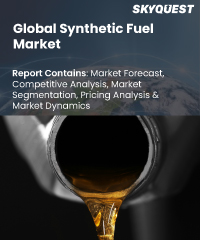
Product ID: SQMIG10G2015

Report ID:
SQMIG10G2015 |
Region:
Global |
Published Date: February, 2024
Pages:
157
|
Tables:
37 |
Figures:
63
Synthetic Fuel Market was valued at USD 4.1 billion in 2019, and it is expected to reach a value of USD 20.84 billion by 2031, at a CAGR of more than 26.15% over the forecast period (2024-2031).
Fuels that are synthetic, or "carbon-neutral," collect CO2 during production. In this method, this greenhouse gas is transformed into a raw material from which power from renewable sources can be used to manufacture gasoline, diesel, and replacement natural gas. The ability to continue using the existing network of filling stations is another significant benefit of combustion engines that run on synthetic fuels. The same is true of the current combustion-engine knowledge. Furthermore, the creation of alternative fuels may be beneficial even though electric vehicles will become substantially less expensive in the next years. Depending on the type of renewable energy utilized, Bosch has estimated that the total cost of ownership of a hybrid-powered by synthetic fuel, up to a lifetime mileage of 160,000 kilometers, might be less than that of a long-range electric vehicle.
US Synthetic Fuel Market is poised to grow at a sustainable CAGR for the next forecast year.
Our industry expert will work with you to provide you with customized data in a short amount of time.
REQUEST FREE CUSTOMIZATIONSynthetic Fuel Market was valued at USD 4.1 billion in 2019, and it is expected to reach a value of USD 20.84 billion by 2031, at a CAGR of more than 26.15% over the forecast period (2024-2031).
The Global Synthetic Fuel market is somewhat fragmented. To maintain a competitive edge, equipment suppliers, current players searching for growth opportunities, and new players as they age. Their business is built on current facts and promising futures by identifying opportunities with other partners to support their plan. 'Sasol (South Africa)', 'Royal Dutch Shell (UK)', 'Bosch (Germany)', 'Air Liquide (France)', 'Air Products and Chemicals Inc. (US)', 'John Wood Group (UK)', 'ROYAL DUTCH SHELL PLC (UK)', 'Syngas Energy Holdings (US)', 'SynGas Technology LLC (US)'
Reduced production costs, which are expected to follow the widespread deployment of variable renewable energy (VRE) sources and are the primary driving force behind cheaper green hydrogen production; and Utilization and monetization of excess renewable energy production, which is expected to increase with increasing supply, to lower the costs of green hydrogen production via electrolysis.
Green hydrogen has the potential to greatly improve sustainability. It could be termed carbon-neutral because it is created using renewable energies. Similarly, burning hydrogen produces energy and water rather than greenhouse gas. Furthermore, hydrogen could aid in the storage of intermittent renewable energies, allowing for smoother energy delivery over longer time periods as well as between regions with ample renewable supply and locations with high energy demand.
There are currently 10 functioning e-fuel projects for the manufacture of green ammonia and methanol, as well as synthetic jet fuel and diesel. The majority of capacity additions in the period 2022-2028 are predicted to be for green ammonia and green methanol. While Asia Pacific, particularly Australia, is likely to become a global leader in green ammonia production, Europe is expected to win the race in green methanol capacity expansions, accounting for more than 86% of total production. Green or e-methanol capacity is expected to stay relatively low when compared to bio methanol produced from waste biomass, owing to the latter's lower costs. E-gasoline, on the other hand, will be mostly produced in Chile, while e-kerosene and other transportation e-fuel manufacturing will be principally supported in Europe. The production of e-fuel will progressively rise, mostly in Europe, the Asia-Pacific region, and potentially in Chile at first. Due to the high energy density requirements, long-distance road transport, aviation, and shipping industries are expected to be the primary sources of e-fuel demand in the medium future, with most of this activity expected to occur in Europe.
Want to customize this report? This report can be personalized according to your needs. Our analysts and industry experts will work directly with you to understand your requirements and provide you with customized data in a short amount of time. We offer $1000 worth of FREE customization at the time of purchase.

Product ID: SQMIG10G2015